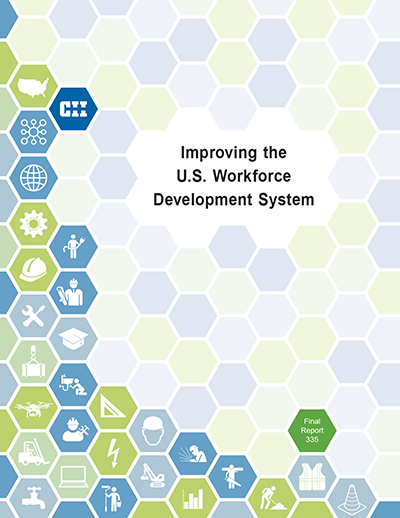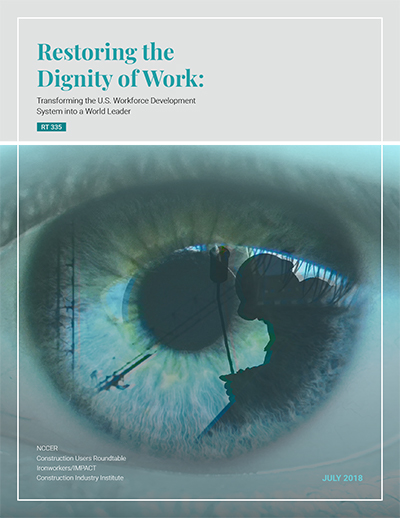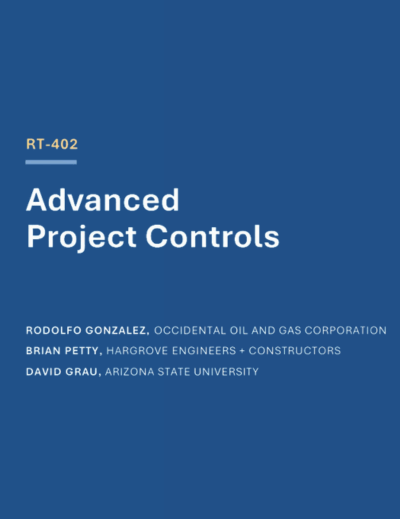
Improving the U.S. Workforce Development System
The construction industry has repeatedly faced the problem of craft professional availability over the past 30 years. During periods of economic expansion, wages for craft professionals typically increase and the average quality of the workforce decreases as less qualified craft professionals enter the industry to take advantage of wage opportunities. During periods of economic contraction, craft professionals are forced to leave the industry and the process repeats itself during the next economic cycle. This phenomenon is well understood by experienced construction personnel. However, recent experiences by construction stakeholders since the 2008 Great Recession indicate that fundamental structural changes have occurred to the construction workforce development system and society as a whole that pose significant risk to the construction industry. The issue of having a qualified workforce can no longer be considered a union or open shop issue but rather a challenge for the entire industry.
RT-318 identified a number of these significant issues facing the North American construction industry. The average age of craft professionals within the industry is increasing and the rate of this increase is four times the national average for all other industries. Most of this is due to young craft professionals not entering the industry. The wage gap between construction craft professionals and all other industries has steadily decreased over the past 30 years at a time when the highest job motivation for craft professionals has evolved from a pride in work accomplished to simply a high wage rate. While there have been pockets of success in some U.S. geographic locations, Hispanics craft professionals have not penetrated the more industrial focused trades (e.g. welder, pipefitter, and electrician) due to low educational attainment at the high school level. Finally, the U.S. education system has been purposely designed over the past 30 years to push young people away from vocational training and into four year colleges and universities. The result of these, and other factors, is that the construction industry is shifting from the long experienced problem of not having enough qualified craft professionals to the problem of not having enough craft professionals period. The result is a statically significant, direct linkage between craft professional availability and construction project safety, cost, and schedule performance. What is most alarming about these trends is that they are largely independent of the traditional economic drivers of construction (e.g. oil prices, GDP); they are indicators of fundamental underlying changes in the U.S. workforce development system.
The lack of an effective workforce development system represents a threat to the economic prosperity of not just the construction industry but the United States as a whole. Workforce development can be described as a four-part process consisting of recruitment to the industry, training for those in the industry, retaining the human resource capital that the industry develops, and placing the craft professional in opportunities for the person to excel throughout their career. In addition, the construction workforce development system involves many organizations across different sectors, outside of construction, and in multiple locations. It is a complex system requires advanced modeling techniques to fully understand the intricacies and factors influencing its performance.
This research answered two essential questions: What can be done to make the U.S. construction workforce development system effective? Which changes will position the U.S. construction workforce development system as a world leader? For the purposes of this research, the workforce development system includes elements of the U.S primary, secondary, and post-secondary education system, construction training, and placement and retention efforts of craft professionals. Elements that were excluded from the scope of the work include unemployment problems (e.g. underemployment), specific primary, secondary, and post-secondary curriculum design, and comprehensive immigration reform.
How did we proposed redesigning the U.S. workforce development system? The required effort goes beyond any single implementation resource, any construction firm, and CII. The effort will require new approaches in how we communicate career opportunities to youth in secondary and post-secondary education, and work-based training among other initiatives. The efforts described in the technical report formulate a series of policy recommendation that have been developed that impact industry stakeholders and governmental agencies. Considering the relative benefits and costs with each policy, there are policies we can be implementing in the short term (less than three years), and there are policies that will require long-term sustained efforts.
Establish and strengthen the awareness of career opportunities in our nation: Most graduating high schools expect to earn a bachelor’s degree for employment opportunities and to make more money, yet most jobs in the U.S. require a CTE education and associated certification. We must establish our nation’s commitment to the equality of all workers by recognizing the dignity of their contribution to society.
Revitalize our work-based learning programs: Despite the tremendous benefits associated with work-based learning, it remains a marginal education strategy in the U.S. Our nation needs to significantly improve participation in work-based learning programs by removing barriers to company participation and promoting its exposure in secondary education.
Measure performance and involvement in workforce development when awarding construction contracts – As owners recognized the importance of safety, they held their contractors to high standards of safety performance, which helped with long-term improvements in worker health and safety. Owners need to assess construction firms’ dedication and commitment to workforce development much like the industry does with safety.
Redefine how we measure the quality of our nation’s secondary education system by career and college readiness: In terms of preparing graduates of our nation’s secondary education system, “career readiness” and “college readiness” are currently used interchangeably. Although academic proficiency is essential for any post-high school achievement, career readiness is a broader concept than just preparing individuals for university studies. At a minimum, all high school graduates should be career ready. The nation’s secondary education system should be provided greater incentive to ensure the career readiness of all high school graduates.
Increase the participation of underrepresented groups in CTE: The groups that represent the greatest opportunity for new workers in the construction industry include women, minorities, and veterans. To increase the numbers of these groups within the construction industry we must increase their presence within secondary and post-secondary CTE programs. This policy helps in recruiting these individuals into construction, but the industry must do a better job of retaining these future professionals with improved worksite conditions and other incentives.
Establish and expand collaboration between industry, education, and government: Industry and business leaders directly feel the challenge of recruiting people in non-managerial roles with required skills, training, and education. To promote CTE in both secondary and post-secondary education levels, the industry has to take an active role promoting industry involvement and investment into our nation’s secondary and post-secondary Career and Technical Education (CTE) programs.
Develop more balanced funding among post-secondary Career and Technical Education versus University Systems: A sizable portion of public education and workforce funding is not effectively allocated to meet the needs of the national economy. The overall governmental funding received by Career and Technical Education programs across the U.S. has declined over the last decade. As a nation, we must increase funding available to CTE programs most needed by industry through both direct funding, incentive programs, and streamlined governmental funding programs.



